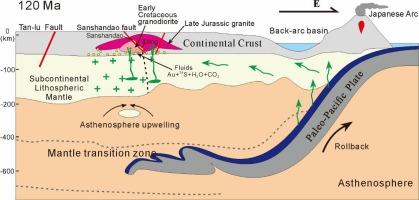Genesis of the Xiling gold deposit, Jiaodong Peninsula, eastern China: Constraints from in situ trace elements and s-pb isotopes of pyrite
IF 3.6
2区 地球科学
Q1 GEOLOGY
引用次数: 0
Abstract
The Xiling gold deposit, a newly discovered ultra-large-scale gold deposit in the Jiaoxibei ore concentration area, has a proven gold reserves of 592 tons and is classified as a fault-related hydrothermal alteration type gold deposit. This study presents in-situ trace element and sulfur-lead isotope data of pyrite from different mineralization stages in the Xiling gold deposit, providing new insights into the genesis of giant gold deposits from the Early Cretaceous. Based on petrographic observation of rocks extracted from drill holes and analysis of backscattered electron (BSE) images, the development of pyrite in the Xiling gold deposit can be divided into 4 stages and 6 subclasses. In situ trace element analysis of pyrite shows that except for stage III, the gold content in the pyrite lattice is very low, mostly less than 1 ppm, with gold mainly existing as invisible gold (lattice gold). From Py1 to Py4, there is a good positive correlation between Au and Ag, As, Sb, Cu, Pb, and Bi, with a trend of increasing content. The trace element analysis results of pyrite indicate that the initial ore-forming fluid originated from the enriched lithospheric mantle. The in situ δ34S values of pyrite indicate a transition in the mineralization environment from compression and reduction to extension and oxidation. In situ Pb isotope results show that the ore-forming fluid extracted lead from the surrounding rocks during migration and mineralization. During the upward migration of the fluid, the tectonic environment experienced a transition from compression to extension, and extracted the ore-forming materials from the surrounding rocks, resulting in the deposition of a huge amount of gold.

胶东西岭金矿床成因:黄铁矿原位微量元素和s-pb同位素的约束
西岭金矿床是焦西北矿集中地区新发现的超大型金矿床,已探明黄金储量592吨,属断层相关热液蚀变型金矿床。本文通过对西岭金矿不同成矿阶段黄铁矿的原位微量元素和硫铅同位素数据的研究,为研究早白垩世巨型金矿床的成因提供了新的思路。根据钻孔提取岩石的岩相观察和背向散射电子(BSE)图像分析,将西岭金矿床黄铁矿的发育划分为4个阶段6个亚类。黄铁矿的原位微量元素分析表明,除ⅲ期外,黄铁矿晶格中的金含量很低,多数低于1 ppm,金主要以不可见金(晶格金)的形式存在。从Py1到Py4, Au与Ag、As、Sb、Cu、Pb、Bi呈良好的正相关关系,且呈增加趋势。黄铁矿微量元素分析结果表明,初始成矿流体来源于富集的岩石圈地幔。黄铁矿的原位δ34S值表明成矿环境由压缩还原向伸展氧化转变。原位Pb同位素结果表明,成矿流体在运移和成矿过程中从围岩中提取铅。在流体向上运移过程中,构造环境经历了由挤压向伸展的转变,并从围岩中提取了成矿物质,形成了大量金的沉积。
本文章由计算机程序翻译,如有差异,请以英文原文为准。
求助全文
约1分钟内获得全文
求助全文
来源期刊

Ore Geology Reviews
地学-地质学
CiteScore
6.50
自引率
27.30%
发文量
546
审稿时长
22.9 weeks
期刊介绍:
Ore Geology Reviews aims to familiarize all earth scientists with recent advances in a number of interconnected disciplines related to the study of, and search for, ore deposits. The reviews range from brief to longer contributions, but the journal preferentially publishes manuscripts that fill the niche between the commonly shorter journal articles and the comprehensive book coverages, and thus has a special appeal to many authors and readers.
 求助内容:
求助内容: 应助结果提醒方式:
应助结果提醒方式:


